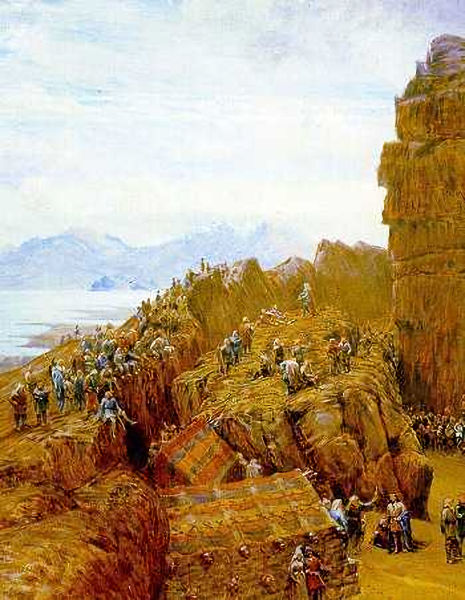Holmgang – Dangerous Viking Duel Settled Disputes
Ellen Lloyd - AncientPages.com - Like in any other ancient society, Norse people had to follow laws and rules, but there were often disputes, and sometimes people decided it was better to solve a matter through a challenge.
Egill Skallagrímsson engaging in Holmgang with Berg-Önundr, a painting by Johannes Flintoe. Credit: Public domain
It was done by a Holmgang, a duel that had to occur within three to seven days after the challenge was announced. Not showing up for the challenge was not a good idea.
If the person challenged did not show up for the Holmgang, then his opponent was considered the winner of the dispute by default. Not turning for a Holmgang caused shame to the entire clan. A person who decided not to participate in a Holmgang was deemed niðingr.
In modern days we would say a coward, but looking through the eyes of the Norse people, it was one of the worst things you could be called. It was a social stigma implying the loss of honor and the status of a villain. The result was that he could be sentenced to an outlaw.
 A Holmgang often resulted in death or severe injuries. Credit: Adobe Stock - alex_marina
A Holmgang often resulted in death or severe injuries. Credit: Adobe Stock - alex_marina
One of the most famous Viking outlaws was Erik the Red, a very controversial Viking. He was very violent, and his temper was beyond his control. It resulted in him being exiled from his country on two occasions!
As the Norse Sagas reveal, honor was significant in Norse society. A Holmgang could be called for in matters involving recognition, retribution, debt, legal disagreement, or intention to help a wife or relative or avenge a friend.
As previously discussed in Ancient Pages, Viking law and order was based on the Thing System. The ancient Viking society had a sophisticated government and law system, but talks and negotiations could not settle certain disputes. Some people demanded payment in blood. For example, in the case of a murder, relatives were expected to require a Holmgang. It often happened that a murder had been sentenced to death or banished from the country for some time, but relatives had the legal right to ask for a Holmgang. Anyone, regardless of social status, could be challenged in a Holmgang.
The Thing system was considered better than having disputes settled by duel or family feuds. In Viking society, all free men and women had the right to conduct revenge killings. Read more
Illustration - The Icelandic Althing in session, as imagined in the 1890s by British artist W. G. Collingwood. Credit: Public Domain
Holmgang can be translated as "to go to (or walk on) a small island." It is because the duel' took place upon a small piece of hiding or cloak placed on the ground. During the fight, the participants had to stay within the marked boundaries. The exact rules varied from place to place and changed over time, but before each challenge, the duelists agreed to the rules they used.
The oldest Holmgangs resulted in death battles or incapacitation of one combatant. Killing an opponent did not constitute murder and therefore did not lead to outlawry, and weregild ( a fine to the victim's family) was not required to be paid by the victor.
In 1006, Iceland declared Holmgangs were no longer allowed, and Norway outlawed the dangerous duel in 1014.
Updated on February 23, 2023
Written by - Ellen Lloyd – AncientPages.com
Copyright © AncientPages.com All rights reserved. This material may not be published, broadcast, rewritten or redistributed in whole or part without the express written permission of AncientPages.com
Expand for referencesMore From Ancient Pages
-
 2,000 Year-Old Books Written By Bian Que The Divine Healer Unearthed
Artifacts | May 13, 2014
2,000 Year-Old Books Written By Bian Que The Divine Healer Unearthed
Artifacts | May 13, 2014 -
 Huge Viking Hall From Harald Bluetooth’s Time Discovered In North Jutland
Archaeology | Dec 22, 2022
Huge Viking Hall From Harald Bluetooth’s Time Discovered In North Jutland
Archaeology | Dec 22, 2022 -
 Unique 8,000 Year-Old Child Burial Reveals Its Secrets
Archaeology | Nov 3, 2020
Unique 8,000 Year-Old Child Burial Reveals Its Secrets
Archaeology | Nov 3, 2020 -
 DNA Study Reveals How Europe’s Hunter-Gatherers Adapted To A New Way Of Life – Farming
Archaeology | Nov 24, 2015
DNA Study Reveals How Europe’s Hunter-Gatherers Adapted To A New Way Of Life – Farming
Archaeology | Nov 24, 2015 -
 Massive Head Of Hercules Pulled From The Antikythera Shipwreck
Archaeology | Jun 23, 2022
Massive Head Of Hercules Pulled From The Antikythera Shipwreck
Archaeology | Jun 23, 2022 -
 Silphium – Remarkable Ancient Herb That Mysteriously Vanished
Ancient Traditions And Customs | Jul 10, 2021
Silphium – Remarkable Ancient Herb That Mysteriously Vanished
Ancient Traditions And Customs | Jul 10, 2021 -
 Magnificent 1,800-Year-Old Rock Tombs Beautifully Decorated Discovered In The Ancient City Of Blaundus
Archaeology | Oct 5, 2021
Magnificent 1,800-Year-Old Rock Tombs Beautifully Decorated Discovered In The Ancient City Of Blaundus
Archaeology | Oct 5, 2021 -
 2000-Year-Old Antikythera Mechanism – Experts Recreate A Mechanical Cosmos For The World’s First Computer
Ancient Technology | Mar 15, 2021
2000-Year-Old Antikythera Mechanism – Experts Recreate A Mechanical Cosmos For The World’s First Computer
Ancient Technology | Mar 15, 2021 -
 Mysterious Judaculla Rock And The Slant-Eyed Giant Of The Cherokee
Featured Stories | May 8, 2021
Mysterious Judaculla Rock And The Slant-Eyed Giant Of The Cherokee
Featured Stories | May 8, 2021 -
 Kukulkan (Quetzalcoatl): Feathered Serpent And Mighty Snake God
Featured Stories | Feb 7, 2017
Kukulkan (Quetzalcoatl): Feathered Serpent And Mighty Snake God
Featured Stories | Feb 7, 2017 -
 Ancient Mothers Cared For Kids Better Than Previously Thought
Archaeology | Nov 29, 2021
Ancient Mothers Cared For Kids Better Than Previously Thought
Archaeology | Nov 29, 2021 -
 Mysterious Disappearance of Scythians Still Remains Unsolved
Civilizations | Sep 6, 2015
Mysterious Disappearance of Scythians Still Remains Unsolved
Civilizations | Sep 6, 2015 -
 Pre-Columbian People Of The Amazon Altered Their Landscape Thousands Of Years Earlier Than Previously Thought
Archaeology | Jun 14, 2021
Pre-Columbian People Of The Amazon Altered Their Landscape Thousands Of Years Earlier Than Previously Thought
Archaeology | Jun 14, 2021 -
 Aqrabuamelu – Mysterious Scorpion Men In Babylonian Mythology
Featured Stories | Jan 19, 2016
Aqrabuamelu – Mysterious Scorpion Men In Babylonian Mythology
Featured Stories | Jan 19, 2016 -
 ‘Tonina Chiapas’ Mayan Pyramid In Southern Mexico Is Among The Largest Yet Found
Civilizations | Oct 29, 2018
‘Tonina Chiapas’ Mayan Pyramid In Southern Mexico Is Among The Largest Yet Found
Civilizations | Oct 29, 2018 -
 A 2,700-Year-Old Urartians’ Ayanis Castle And Haldi Temple – Soon An Open-Air Museum
Archaeology | Aug 10, 2020
A 2,700-Year-Old Urartians’ Ayanis Castle And Haldi Temple – Soon An Open-Air Museum
Archaeology | Aug 10, 2020 -
 The First Australians Ate Giant Eggs Of Huge Flightless Birds That Went Excinct Over 47,000 Years Ago
Archaeology | May 25, 2022
The First Australians Ate Giant Eggs Of Huge Flightless Birds That Went Excinct Over 47,000 Years Ago
Archaeology | May 25, 2022 -
 Olduvai Gorge: Direct Cosmogenic Nuclide Dating Of Olduvai Lithic Industry
News | Mar 31, 2022
Olduvai Gorge: Direct Cosmogenic Nuclide Dating Of Olduvai Lithic Industry
News | Mar 31, 2022 -
 What Happened To The Ancient Tribe That Entered A Secret Underground World And Never Came Back?
Featured Stories | Feb 1, 2021
What Happened To The Ancient Tribe That Entered A Secret Underground World And Never Came Back?
Featured Stories | Feb 1, 2021 -
 Llyn Y Dywarchen – Enigmatic Lake Shrouded In Myth And Legend
Featured Stories | Jun 29, 2021
Llyn Y Dywarchen – Enigmatic Lake Shrouded In Myth And Legend
Featured Stories | Jun 29, 2021


